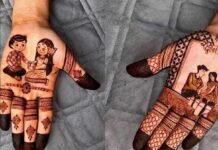Mehndi designs for hands and legs have been an integral part of cultural celebrations and rituals for centuries, with each region boasting its own unique style and symbolism. Prepare to be enchanted as we delve into the captivating realms of Mandala, Rajasthani, and Tribal Mehndi designs for hands and legs.



Get ready to embark on a vibrant journey through the intricate patterns, cultural heritage, and timeless elegance of these unique Mehndi styles.
Whether you’re a Mehndi aficionado seeking inspiration or a bride-to-be dreaming of intricate bridal adornments, these Mehndi designs for hands and legs promise to ignite your imagination and leave a lasting impression.
So, buckle up and prepare to be dazzled as we journey through the captivating worlds of Mandala, Rajasthani, and Tribal Mehndi designs!
Captivating Circles: Mandala Mehndi Design
Mandalas, derived from the Sanskrit word for “circle,” are geometric configurations that hold deep spiritual significance in various cultures around the world. Now, I know what you’re thinking—what’s the deal with Mandala Mehndi designs anyway?





In Mehndi art, mandalas are often used as focal points or central motifs, surrounded by intricate patterns and designs that radiate outward like petals of a flower.
The beauty of mandala mehndi patterns lies in their symmetrical nature, with intricate details mirroring each other on opposite sides of the design. The symmetry not only enhances the visual allure but also instills a feeling of equilibrium and tranquility, captivating and comforting the observer’s gaze.
From contemporary twists to experimental flourishes, Mandala Mehndi designs continue to evolve, inspiring Mehndi artists and enthusiasts alike to push the boundaries of creativity.
One of the most popular mandala mehndi patterns for hands is the central mandala design, where a large circular motif serves as the focal point of the design.
Surrounding the central mandala are intricate patterns of paisleys, flowers, leaves, and geometric shapes, all arranged in a symmetrical fashion to create a stunning visual effect.
Another common mandala mehndi pattern is the mandala chain, where multiple smaller mandalas are linked together in a continuous chain-like pattern that wraps around the hand.
This design is often seen on the back hand, extending from the wrist to the fingertips, creating a mesmerising cascade of mandala motifs.
Why not Mandala’s for legs?
The common pattern for Mandala Mehndi designs on legs is the ankle bracelet design, where Mandala motifs are arranged in a circular pattern around the ankles, resembling traditional Indian anklets.




These ankle bracelets add a touch of femininity and charm to the overall design, creating a mesmerising effect that complements the natural contours of the legs. In addition to circular Mandala motifs, geometric patterns such as triangles, squares, and hexagons are often incorporated into Mandala Mehndi designs for legs.
These geometric shapes add visual interest and depth to the design. In addition to traditional mandala designs, modern interpretations of mandala mehndi patterns have also emerged, incorporating contemporary elements such as negative space, abstract shapes, and experimental flourishes.
And so, dear Mehndi mavens, we bid adieu to our whirlwind tour through the bewitching world of Mandala Arabic designs.
From the hypnotic swirls to the mesmerising symmetry, Mandala designs have proven themselves to be the life of the Mehndi party, turning heads and stealing hearts wherever they go. So go forth, embrace the circles.
Tribal Tales: Tribal Mehndi Designs
In the vast tapestry of Mehndi art, Tribal designs stand out as bold, primal expressions of culture and tradition. From ancient rituals to modern interpretations, Tribal Mehndi designs for hands weave together intricate patterns, symbolic motifs, and a rich tapestry of history.






Join us on a journey as we delve into the captivating world of Tribal Mehndi designs and unravel the secrets behind their timeless allure.
Tribal Mehndi designs draw inspiration from indigenous cultures around the world, incorporating motifs and symbols that hold deep significance within tribal communities.
These designs often feature bold geometric patterns, stylised animals, and ravelled symbols that reflect the unique heritage and beliefs of each tribe.
Tribal designs make a statement with their strong lines, sharp angles, and powerful imagery. These designs exude a sense of strength, resilience, and connection to the natural world, making them a favourite among those seeking to express their inner warrior spirit.
Style plays a key role in Tribal Mehndi designs, with each pattern reflecting the cultural identity and artistic sensibilities of the tribe from which it originates.
Some Tribal designs are characterised by symmetrical patterns and repeating motifs, while others feature asymmetrical compositions and free-flowing lines. Regardless of the style, Tribal Mehndi designs are united by their raw energy and primal beauty.
In the wild world of Tribal Mehndi designs, the patterns are as diverse as a jungle safari! Picture this: you’ve got animals like wolves, eagles, and snakes strutting their stuff alongside geometric shapes like triangles, diamonds, and chevrons. It’s like a party where Mother Nature herself is the DJ, spinning tunes of strength, wisdom, and harmony.
So, why the animal motifs, you ask? Well, it’s all about tapping into your inner beast! Wolves symbolise strength, eagles represent wisdom, and snakes—well, let’s just say they’re the protectors of the Mehndi realm.
And as for the geometric patterns, they’re like the blueprint of the universe, symbolising unity, balance, and a whole lot of mathematical magic.
But here’s the kicker: Tribal Mehndi designs aren’t just about looking fierce—they’re also steeped in mythology and spiritual symbolism. So, the next time you’re rocking a Tribal Mehndi pattern, remember that you’re not just adorning your hands—you’re channeling the wisdom of ancient tribes, communing with nature, and unleashing your inner warrior all at once.
Echoes of Rajasthan: Rajasthani Mehndi Designs
Get ready to embark on a hilarious journey through the desert state of Rajasthan, where Mehndi art is not just about complicated patterns but also about bringing a smile to your face. So, grab your chai and let’s dive into the world of Rajasthani Mehndi designs.






What sets Rajasthani Mehndi designs apart are the embodiment of peacocks. The peacock—Rajasthan’s unofficial mascot and the star of every Mehndi ceremony.
These majestic birds are so revered in Rajasthani culture that they even make an appearance on your hands! With their majestic beauty and vibrant plumage, peacocks are symbols of grace and royalty in Rajasthani culture.
In Mehndi art, peacock motifs are often intricately detailed, with swirling feathers and delicate patterns adorning the hands.
Next up, we have the paisleys! Paisley motifs are another hallmark of Rajasthani Mehndi designs. These teardrop-shaped motifs, also known as “aam” or mango motifs, are inspired by the lush gardens and fruit orchards of Rajasthan.
In Mehndi art, paisleys are often arranged in elaborate patterns, with intricate detailing and embellishments. These motifs symbolise, abundance, and good fortune, making them an auspicious choice for Mehndi ceremonies and festive celebrations in Rajasthan.
Mirror, mirror, on the Mehndi—wait, what? That’s right, folks, in Rajasthani Mehndi designs, even the mirrors get in on the Mehndi action! Mirror work, or “shisha,” is a traditional Rajasthani embroidery technique that is often incorporated into Mehndi designs.
Small pieces of mirrored glass are stitched onto fabric or applied onto Mehndi paste to create shimmering accents and reflective patterns. The mirror work adds a touch of sparkle and glamour to the hands, enriching the overall beauty of the Mehndi artwork.
Last but not least, we have the geometric patterns—because who says Mehndi can’t be a little bit nerdy? These shapes and lines may look like something out of a math textbook, but these geometric patterns are like the cool kids of the Mehndi world—edgy, modern, and totally hip.
These geometric patterns are inspired by architectural elements, such as lattice screens and jaali work, which are commonly found in Rajasthani palaces and forts.
From peacock motifs to paisleys, mirror magic, geometric goodies, and flowery fancies, Rajasthani Mehndi designs are like a buffet of beauty for Mehndi lovers.
Whether you’re a bride hunting for bridal bling or a Mehndi lover seeking inspiration from Rajasthani culture, these captivating hand patterns are sure to leave a lasting impression.
Overview
As we bid adieu to our whirlwind tour of Mehndi wonderlands—Mandala, Rajasthani, and Tribal—we can’t help but feel a pang of Mehndi-induced nostalgia. Mehndi artistry is not just about patterns on skin, but about the stories they tell, the traditions they uphold, and the connections they forge between past, present, and future.
Our journey through Mehndi has been akin to a thrilling rollercoaster ride, from the precise symmetry of Mandala designs to the regal allure of Rajasthani motifs and the untamed charm of Tribal patterns. It’s been a whirlwind exploration of diverse colours and cultures, leaving us exhilarated and enriched.
Just like the fusion of Mandala with Rajasthani motifs or Tribal patterns with modern flair, creativity knows no bounds in the world of Mehndi. So, let your imagination run wild, experiment with different styles and techniques, and who knows? You might just stumble upon your own Mehndi masterpiece!




